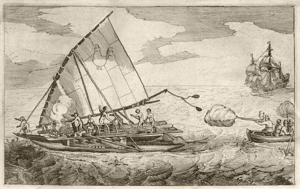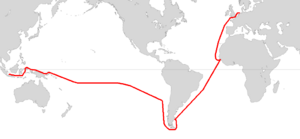Willem Schouten facts for kids
Quick facts for kids
Willem Schouten
|
|
|---|---|

Willem Schouten by Mattheus Merian in 1631
|
|
| Born | c. 1567 |
| Died | 1625 Antongil Bay
|
| Nationality | Dutch |
| Occupation | Navigator |
Willem Cornelisz Schouten (born around 1567 – died 1625) was a brave Dutch navigator and explorer. He worked for the Dutch East India Company, a big trading company. Willem Schouten was the first person to sail around Cape Horn at the very bottom of South America. This new route opened up a way to reach the Pacific Ocean.
Contents
Willem Schouten's Early Life
Willem Cornelisz Schouten was born around 1567. His hometown was Hoorn in Holland, which was part of the Seventeen Provinces at that time.
The Famous Expedition of 1615
In 1615, Willem Schouten started an important sea journey. He sailed from Texel in the Netherlands with his younger brother, Jan Schouten. This trip was led by Jacob Le Maire. It was paid for by Isaac Le Maire and his company, the Australische Compagnie, along with Schouten.
Ships and Goals of the Voyage
The expedition used two ships: the Eendracht and the Hoorn. One main goal was to search for a large southern land called Terra Australis. Another goal was to find a new way to the Pacific Ocean. This new route would help them avoid the rules of the Dutch East India Company (VOC). The VOC had a monopoly, meaning they controlled most trade to the Spice Islands.
Discovering a New Route
In 1616, Schouten achieved something amazing. He sailed around the southernmost tip of South America. He named this point Cape Horn. He named it after his ship, the Hoorn, which had been lost. He also named it after his hometown, Hoorn. Schouten named the narrow passage of water there "Le Maire Strait."
Sadly, Jan Schouten, Willem's brother, passed away on March 9, 1616. This happened after the ships left the Juan Fernández Islands.
Crossing the Pacific Ocean
After rounding Cape Horn, Schouten crossed the Pacific Ocean. He sailed along a southern path. During this part of the journey, he discovered many small islands. These included atolls in the Tuamotu Islands, like Puka-Puka, Manihi, Rangiroa, and Takapoto.
He also found islands in the Tonga Islands, such as Tafahi, Niuafoʻou, and Niuatoputapu. Later, he reached Alofi and Futuna in the Wallis and Futuna Islands.
Reaching the Spice Islands
Schouten then followed the northern coasts of New Ireland and New Guinea. He visited islands nearby, including those now known as the Schouten Islands. Finally, he reached Ternate in September 1616.
Challenges with the Dutch East India Company
Even though Willem Schouten found a new sea route, the VOC was not happy. They said he broke their trading rules for the Spice Islands. Schouten was arrested, and his ship was taken in Java. He was later released.
After this, he continued to sail for the VOC. He passed away off the coast of Madagascar in 1625 during one of these trips.
Later, another famous explorer, Abel Tasman, used Schouten's maps. These maps helped Tasman explore the northern coast of New Guinea.
Schouten's Published Journal

Willem Schouten wrote about his travels in a book called the Journal. It was first published in Dutch in Amsterdam in 1618. Soon after, it was translated into many other languages.
Different Editions of the Journal
Here are some of the first editions of his journal:
- Dutch edition: Journael ofte beschrijvinghe van de wonderlijcke reyse, gedaen door Willem Cornelisz. Schouten van Hoorn, in de Jaren 1615. 1616. en 1617... (Amsterdam, 1618).
- French edition: Journal ou Description du marveilleux voyage de Guilliaume Schouten (Amsterdam, 1618).
- English edition: The Relation of a Wonderfull Voiage made by Willem Cornelison Schouten of Horne... (London, 1619).
- German edition: Journal, oder Beschreibung der wunderbaren Reise W. Schouten auss Hollandt, im Jahr 1615–17... (Frankfurt am Main, 1619).
- Latin edition: Novi Freti, a parte meridionali freti Magellanici in Magnum Mare Australe Detectio... (Amsterdam, 1619).
Historians are not completely sure who wrote every part of this Journal. Many believe Schouten was the main author, which is why the voyage is known by his name. The Dutch, French, German, and Latin versions of the book include nine maps and pictures. The English version, THE RELATION, does not have these.
See also
 In Spanish: Willem Schouten para niños
In Spanish: Willem Schouten para niños


